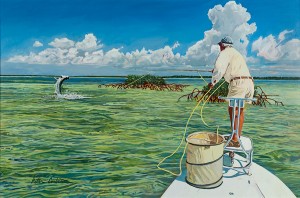Fly Fishing Art by Corbin ’68 on Exhibit at National Sporting Library and Museum

oil on canvas, 20 x 30 inches, 2014
Private Collection
The exhibition, Line Dance—The Art of Fly Fishing by Peter Corbin ’68, is now on view at the National Sporting Library and Museum (NSLM), Middleburg, Va., through July 3, 2016.
Sporting artist Corbin, who majored in art at Wesleyan and graduated with high honors, notes that he considers himself first a landscape painter, with the sporting matter as a part of the scene. The 15 large paintings—spanning nearly four decades of creativity—are on loan to the NSLM from collectors.
Initially an abstract sculptor, Corbin notes that now, as a representational painter, he is still exploring some of the same principals that absorbed him then. “My fascination with both reflected and transmitted light, and the elements of asymmetrical balance and linear motion, all come together in the realism of the sport of fly fishing, which, for me, is the most direct form of fishing that exists,” he said.
Author and editor John Merwin (1921-2013), who wrote on angling and knew Corbin over many years, spoke to this quality of mind that is on dispaly in Corbin’s art: “[…]Corbin possesses that sort of restless intellect that never stops evolving[…]” (foreword to An Artist’s Creel, Hudson Hill Press, Inc., 2005).
To accompany the exhibition, Corbin prepared a slide show video. There, he speaks of not only of the meticulous process of creating his art, but also the philosophy behind it, as well as his deep love of flyfishing and the natural environment. He places his paintings into a narrative arc, with three distinct segments: “The first is a painting of anticipation such as an angler starting his cast and a guide positioning the boat. The second kind of painting is a frozen moment when time seems to stop and the image is etched into your mind… for example the first massive jump of a tarpon. The third is the painting of reflection. This is the quiet time of the day with the angler against the sunset or releasing a fish.”
For more information about the exhibition, visit NationalSporting.org.

